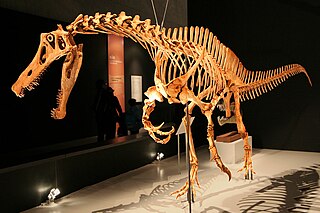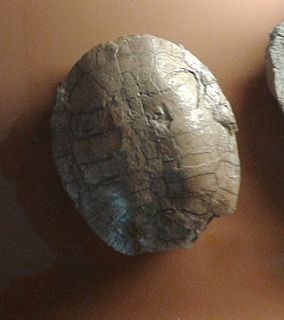
Chelidae is one of three living families of the turtle/tortoise suborder Pleurodira, and are commonly called Austro-South American side-neck turtles. The family is distributed in Australia, New Guinea, parts of Indonesia, and throughout most of South America. It is a large family of turtles with a significant fossil history dating back to the Cretaceous. The family is entirely Gondwanan in origin, with no members found outside Gondwana, either in the present day or as a fossil.

The Crato Formation is a geologic formation of Early Cretaceous (Aptian) age in northeastern Brazil's Araripe Basin. It is an important Lagerstätte for palaeontologists. The strata were laid down mostly during the early Aptian age, about 113 million years ago, in a shallow inland sea. At that time, the South Atlantic was opening up in a long narrow shallow sea.

Irritator is a genus of spinosaurid dinosaur that lived in what is now Brazil during the Albian stage of the Early Cretaceous Period, about 110 million years ago. It is known from a nearly complete skull found in the Romualdo Formation of the Araripe Basin. Fossil dealers had acquired this skull and illegally sold it to the State Museum of Natural History Stuttgart. In 1996, the specimen became the holotype of the type species Irritator challengeri. The genus name comes from the word "irritation", reflecting the feelings of paleontologists who found the skull had been heavily damaged and altered by the collectors. The species name is a homage to the fictional character Professor Challenger from Arthur Conan Doyle's novels.

Santanaraptor is a genus of theropod dinosaur that lived in South America during the Early Cretaceous, about 112 million years ago.

Tropeognathus is a genus of large pterosaurs from the late Early Cretaceous of South America. This genus is considered to be a member of the family Anhangueridae, however, several studies have also recovered it within another family called Ornithocheiridae. Both of these families are diverse groups of pterosaurs known for their keel-tipped snouts and large size. Tropeognathus is regarded as the largest pterosaur found in the Southern Hemisphere, only rivaled by the huge azhdarchids. The type and only species is Tropeognathus mesembrinus. Fossil remains of Tropeognathus have been recovered from the Romualdo Formation, which is a Lagerstätte located in the Santana Group of the Araripe Basin in northeastern Brazil.
Araripesaurus was a pterosaur belonging to the suborder Pterodactyloidea, it was discovered in the Romualdo Formation of the Santana Group in northeastern Brazil, which dates back to the Aptian and Albian of the Early Cretaceous. The type species is A. castilhoi.
Brasileodactylus a genus of pterosaur from the Aptian-age lower Santana formation of Chapada do Araripe, Ceará, Brazil.

Mesodermochelys is an extinct genus of sea turtle known from the Campanian to the Maastrichtian of what today is Japan. One species is known, the type species M. undulatus; it was given its binomial name by Ren Hirayama and Tsutomu Chitoku in 1996. Studies of its skull indicate that it was a primitive member of the Dermochelyidae that was closely related to the Protostegidae. It has been described as the best representative of Mesozoic dermochelyids.

Cearachelys is an extinct genus of pleurodiran turtle which existed some 80 million years ago. The genus is monotypic, with only type species Cearachelys placidoi known.
Santanichthys diasii is a species of extinct fish that existed around 115 million years ago during the Albian age. S. diasii is regarded as the basal-most characiform, and is the earliest known member of Otophysi. It appears as a small fish, similar in appearance to a modern-day herring little more than 30 millimeters in length. Its most striking characteristic is the presence of a Weberian apparatus, which makes it the most primitive known member of the order Characiformes, the order in which modern-day tetras are classified. Santanichthys has been unearthed from numerous locations throughout Brazil, in rocks dating to the Cretaceous Period. Its presence in these strata is seen as an indicator for the biogeography and evolution of its order.
Eurycephalella is an extinct genus of frogs which existed in what is now Brazil during the Early Cretaceous (Aptian). It was named by Ana M. Báez, Geraldo J.B. Moura and Raúl O. Gómez in 2009, and the type species is Eurycephalella alcinae.
Unwindia is a genus of pterodactyloid pterosaur from the Early Cretaceous period of what is now modern-day Brazil.

Maaradactylus is a genus of anhanguerid pterodactyloid pterosaur known from the Lower Cretaceous period of the Romualdo Formation of northeastern Brazil.

The Araripe Basin is a rift basin covering about 8,000 square kilometres (3,100 sq mi), in Ceará, Piauí and Pernambuco states of northeastern Brazil. It is bounded by the Patos and Pernambuco lineaments, and is situated east of the Parnaíba Basin, southwest of the Rio do Peixe Basin and northwest of the Tucano and Jatobá Basins.

Bauruemys is an extinct genus of turtles in the family Podocnemididae.

The Presidente Prudente Formation is a geological formation of the Bauru Group in the Paraná Basin, located in Brazil whose strata date back to the Late Campanian to Early Maastrichtian.

The Santana Group is a geologic group, formerly included as the middle part of the Araripe Group, in the Araripe Basin of northeastern Brazil. The group comprises the Crato, Ipubi and Romualdo Formations and is dated to the Aptian to Albian stages of the Early Cretaceous. The formations of the group were deposited in a lacustrine to subtidal shallow marine environment in the Araripe rift basin.

The Ipubi Formation is the middle geological formation of the Santana Group, the middle part of the Araripe Group, in the Araripe Basin of northeastern Brazil. The formation is dated to the Aptian to Albian stages of the Early Cretaceous, unconformably overlying the Crato Formation and unconformably overlain by the Romualdo Formation, formerly known as the Romualdo Member of the Santana Formation. The averaging 15 metres (49 ft) thick Ipubi Formation comprises shales and sandstones in the lower section and evaporites in the upper part of the formation, deposited in a transgressive to highstand lacustrine environment in the Araripe rift basin.

The Maria Farinha Formation is a geological formation of the Parnaíba Basin in Pernambuco, northeastern Brazil whose strata date back to the Danian stage of the Paleocene, or Tiupampan in the SALMA classification.
Itapecuruemys is an extinct genus of bothremydid pleurodiran turtle that was discovered in the Itapecuru Formation of Brazil. It is a monotypic genus, with only type species Itapecuruemys amazoniensis known.










